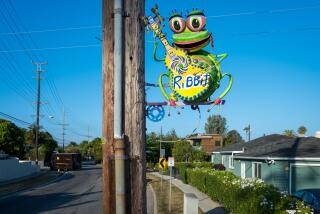There’s Enough Room for Art and Architecture : Commentary: Culver City’s decision to revise its art in public places program sends a message that artists are expendable and sets a dangerous precedent. It should be reversed.
In Culver City, artists are expendable.
That’s the blunt message sent last March, when the City Council made a bizarre revision of Culver City’s art in public places program--one that sent shock waves through the national arts community.
The volatile subject will be revisited tonight, as the City Council holds a public discussion on its controversial action. The fun begins at 7 p.m. in council chambers at the interim City Hall, Overland Avenue and Culver Boulevard.
The original ordinance, like those in many other American cities, required that 1% of construction costs of major new public and private developments must go toward acquiring public art. The virtually unprecedented revision of the plan says that, in certain circumstances, the new building itself could satisfy the requirement.
If the city likes the design of a new building, the art requirement will be considered to have been met. Where architecture and art were both once encouraged to flourish, now architecture will be eligible to replace art.
How this diminishment qualifies as an improvement is anybody’s guess.
Both architects and artists can be expected to be on hand tonight to argue for and against the March decision, which was opposed from the start by the city’s own advisory art committee.
The ordinance change was instigated by developer Frederick Smith and architect Eric Owen Moss, who are jointly executing several projects in Culver City. In advance of the March meeting, they lined up support for the change from a variety of sources, among them Museum of Contemporary Art director Richard Koshalek and curator Elizabeth Smith, who have organized several architecture shows at the museum.
According to a City Council report, Moss and Frederick Smith first approached the city’s art committee in early 1992 about waiving the percent-for-art requirement on an already completed building renovation, based on the artistic quality they claimed for the project. The request was denied.
A second request on another building renovation was made in November, 1992, the report says. Smith and Moss stated that a “steel ring, trusses and a circular piece on the roof were designed as artwork” by Moss, with the intention of meeting the art requirement.
The art committee deliberated over the second plan on several occasions, the report says, ultimately denying the request in March, 1993. Basing their decision on a similar public art ordinance in Los Angeles, the committee unanimously voted to declare ineligible as project artists either participating architects, members of any consulting firms or “anyone with a vested or familial relationship” to them.
A year later, the City Council made its cataclysmic revision. Henceforth, a positive assessment of the architecture’s quality, pending recommendation by the arts committee and subject to case-by-case review by the City Council, will qualify as having fulfilled the art in public places ordinance.
While its supporters have claimed the change as a visionary recognition of architecture’s civic significance, the acknowledgment has come at the cost of art. With one hand it places a laurel wreath on the architect’s head, with the other it shoos the artist out of sight.
The fallout of this less-is-more decision has been extreme. Hard-fought public art programs everywhere have been jeopardized by the precedent.
Ultimately, the revision makes no sense, for the uniquely creative capacity of architects is already being tapped in public projects.
More to Read
The biggest entertainment stories
Get our big stories about Hollywood, film, television, music, arts, culture and more right in your inbox as soon as they publish.
You may occasionally receive promotional content from the Los Angeles Times.











